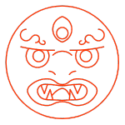<Theosophical Conference 2017, Osaka>
第4セッション 芸術と秘教思想
4th session ART AND ESOTERICISM
日時:2017年3月7日午後4時〜6時
Date and time: March 7, 2017, 4:00 pm-6:00 pm
場所:国立民族学博物館第4セミナー室
Venue: Seminar Room 4, National Museum of Ethnology, Osaka
発表者:日沖直子
Presenter : Naoko Frances HIOKI
題目:大本教・出口王仁三郎の芸術と神智学(英語、通訳つき)
Title: Japanese Spiritology Meets Theosophy: Aura Mapping and the Art of Deguchi Onisaburo (in English, with an interpreter)
概要
20世紀前半の代表的新宗教団、大本(教)を率いた出口王仁三郎(1871-1948)は第二次大戦末期から戦後にかけて2年に満たない短い期間に大量の楽焼作品(耀盌)を作成し信者に配布した。当時を知る信者の証言によると、作品数は数千におよび、王仁三郎自らリヤカーに積んで配り歩いたこともあったという。彼が特に気に入った茶碗には『天国廿八』など、天国という言葉に数字を組み合わせた銘がつけられていた。これらの楽茶碗は王仁三郎の死後、美術評論家の加藤義一郎にその価値を見出され、王仁三郎と出口家の人々の書や水墨画の作品と共に日本国内はもとより欧米で開催された展覧会で好評を博してきた。耀盌というのは加藤が名付けたものである。
『天国』シリーズをはじめとする耀盌の特徴はそれまで「侘び寂び」の美意識を重視する伝統的な楽焼には使われることのなかった鮮やかな色彩を取り入れたことである。特に注目したいのが、王仁三郎作品の抽象柄と色彩がドイツ表現派の画家、W. カンディンスキー(1866-1944)の1910年代の作品に酷似していることであり、これは耀盌が欧米で高い評価を得たことの理由のひとつであると考えられる。抽象絵画の祖であり、神智学と関わりの深かったカンディンスキーの美術理論については1920年代に日本でも翻訳が出版されていたが、彼の作品を王仁三郎が知っていたという記録は出ていない。しかし特にカンディンスキーの初期抽象画に影響を与えたとされるオーラとThought-Formsの理論については、オーラ図が戦前の日本で一時ブームになっていたこと、大本幹部による紹介本が刊行されていたことなどから、海外の心霊学情報に敏感だった王仁三郎が注目していたことは確かである。ただ、王仁三郎は自作品のいわゆる「芸術的価値」には無関心であった。信者にとってはむしろ言霊がこめられた作品のひとつひとつは彼の霊力が形になったものであった。技術的にはかなり劣っていたと考えられる初期の陶芸作品についても、王仁三郎作の茶碗から水を飲み娘の病気が治ったとの証言が残っており、また海外の宣教でも茶碗が配られその癒しの力が信じられていた。
このように伝統的楽焼とは全く異なる耀盌の色彩は、神智学、特にオーラ理論にインスパイアされたものである可能性が高く、そこにドイツ表現派の抽象絵画とのつながりを見ることが出来る。またそれらは20世紀前半の日本の知識人に見られた「近代」オカルトへの関心、あるいは東西文化の融合の奇異な一例だったと考えることもできる。しかし、ここで重要なのは王仁三郎が欧米人の感性にもアピールするオーラ色に彩られた楽茶碗を大量に手作りし、戦後の苦境にあえいでいた信者たちに配り与えることによってHigh Art(芸術)とFolk Art(民芸)の垣根をラディカルに取り払ったこと、ある意味で、同時代の民芸運動がなしえなかったことをやりとげたことにあるではないだろうか。
Abstract
This paper explores sources of inspiration for the artwork of Deguchi Onisaburo (1871–1948), the charismatic Japanese leader of the Omoto spiritual movement. In particular, it focuses on the series of ceramic teacups titled “Heaven (tengoku in Japanese),” which was produced in the 1940s, shortly after he was released from prison, where he had been kept on a charge of subversion. Otomo records show that Onisaburo created thousands of teacups and distributed them to his followers for free. It was only after his death, however, that the artistic value of the “Heaven” series and Onisaburo’s other ceramics was recognized by the art critic Kato Gi’ichiro. In 1949, Kato organized the first exhibition of Omoto art in Osaka with great success. Over the next thirty years, exhibitions followed in various parts of Japan, Europe, and the United States.
The “Heaven” teacups are remarkable, as they feature luminous, bright colors that had never been used for traditional Japanese raku ware, which favors rustic taste and colors. Most significantly, Onisaburo’s palette demonstrates a striking resemblance to that of the German expressionist, Wassily Kandinsky (1866-1944), which probably contributed to their favorable reception in the West. Onisaburo’s writings do not say whether he knew of Kandinsky’s abstract paintings, but there are sources that indicate he was aware of early twentieth-century Theosophists’ “thought-forms” and aura theory, which had considerable influence upon some of Kandinsky’s famous works. Unlike Kandinsky, who experimented with different styles for richer and more powerful visual expression, Onisaburo disregarded aestheticism. Rather, he intended his products to be the materialization of his spiritual power. He claimed that he infused word-spirit into each cup. One of his followers attested that the water from the cup healed his daughter’s illness. They were also used in Omoto’s overseas missions as tokens of the mysterious healings that Otomo spiritology offered to believers.
The unusual adoption of aura colors in Japanese raku ware may be an example of the East-West syncretism that was prevalent in the occult-intellectual circles of the early twentieth century; more importantly, however, with his teacups, Onisaburo abolished the walls between “East” and “West,” “high art” and “folk art,” and “secular art” and “religious art,” and he radically popularized Western, modernist spiritualism for the common people in Japan.
発表者プロフィール Profile
所属:南山大学宗教文化研究所
Academic affiliation : Associate Researcher, Nanzan Institute for Religion and Culture
研究分野:芸術と宗教
Research field : Art and religion
主な業績 Major publication (in Japanese):
「高橋五郎訳『聖福音書』をめぐって―明治のカトリック教会についての一考察―」『アジア・キリスト教・多元性』第14号(2016)
Major publications (in English):
“Depictions of the Journey to the Heavenly Realm in Early Modern Catholic and Japanese Buddhist Iconography.” Religion and the Arts 20 (2016).
“Deconstructing Maria-Kannon: A New Look at the Marian Image for Urakami Crypto-Christians, ca. 1860.” Japanese Religions 40 (2015).
“Tea Ceremony as a Space for Interreligious Dialogue.” Exchange, 42/2 (2013).
“Visual Bilingualism and Mission Art: A reconsideration of ‘Early Western-Style Paintings’ in Japan.” Japan Review 23 (2011).
現在の研究:
「マリア観音」のイメージと言説―明治・大正から今日まで―
アメリカ表現主義派と禅―鈴木大拙著作の受容から考える―
Works in progress:
Image and discourse on “Maria-Kannon” from Meiji to the present
D.T. Suzuki and Abstract Expressionism in America
